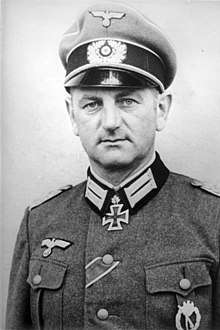Otto Hitzfeld
Otto Maximilian Hitzfeld (7 May 1898 – 6 December 1990) was a German general during World War II. He was listed as a recipient of the Knight’s Cross with Oak Leaves and Swords by the West German Association of Knight's Cross Recipients. He is the uncle of retired football manager Ottmar Hitzfeld.[1]
Otto Hitzfeld | |
|---|---|
 Otto Hitzfeld as colonel on 25 February 1942 | |
| Born | 7 May 1898 Schluchsee |
| Died | 6 December 1990 (aged 92) Dossenheim |
| Allegiance | |
| Service/ | Army (Wehrmacht) |
| Years of service | 1914–45 |
| Rank | General of the Infantry |
| Commands held | 102nd Infantry Division LXVII Army Corps 11th Army |
| Battles/wars | World War II |
| Awards | Knight's Cross of the Iron Cross with Oak Leaves and Swords |
Career
Hitzfeld received command of the 102nd Infantry Division in April 1943. He was promoted to Generalleutnant early November 1943 and had to turn over command of the Division. He then took command of the infantry school in Döberitz and again turned over command on 1 November 1944. Hitzfeld was given command of the LXVII Army Corps, which he led in the Battle of the Bulge. He was promoted to General of the Infantry on 1 March 1945 and made commanding general of the LXVII Army Corps.
He became commander of the 11th Army in April 1945. He declared Göttingen, which was crowded with refugees, as an open city. He was taken prisoner of war by American forces on 19 April 1945 from which he was released on 12 May 1947. He received news that he had been awarded the Knight's Cross of the Iron Cross with Oak Leaves and Swords after his release from captivity.
Awards
- Iron Cross (1914) 2nd Class (5 November 1915 & 1st Class (5 September 1916))[2]
- Clasp to the Iron Cross (1939) 2nd Class (25 August 1940) & 1st Class (15 August 1941)[2]
- Officers Cross of the Order of the Crown with Swords (22 June 1942)
- Knight's Cross of the Iron Cross with Oak Leaves and Swords
- Knight's Cross on 30 October 1941 as Oberstleutnant and commander of Infanterie-Regiment 213[3][4]
- 65th Oak Leaves on 17 January 1942 as Oberstleutnant and commander of Infanterie-Regiment 213[3][5]
- 158th Swords on 9 May 1945 as General der Infanterie and commanding general of the LXVII. Armeekorps[6][Notes 1]
Notes
- Otto Hitzfeld's nomination was rejected by Major Joachim Domaschk on 30 April 1945 and commented: "This is not a nomination!" (Only leadership and organisational achievements, no personal bravery) he additionally noted: "missing in cauldron AOK 11". The nomination was thus assessed as insufficient as well as postponed according to AHA 44 Ziff. 572. The entry date noted on the nomination list for the higher grades of the Knight's Cross of the Iron Cross is 28 April 1945. The list indicates a note "deferred". The approval cannot be proven. The order commission of the Association of Knight's Cross Recipients (AKCR) handled the case in 1981 and decided: Swords yes, 9 May 1945. The AKCR claims that the award was presented in accordance with the Dönitz-decree. This is illegal according to the Deutsche Dienststelle (WASt) and lacks legal justification. The sequential number "158" and presentation date was assigned by the AKCR. Hitzfeld was member of the AKCR.[7]
References
Citations
- "Ottmar Hitzfeld: 5 Fast Facts You Need to Know". Heavy. Retrieved 12 January 2018.
- Thomas 1997, p. 286.
- Scherzer 2007, p. 393.
- Fellgiebel 2000, p. 228.
- Fellgiebel 2000, p. 57.
- Fellgiebel 2000, p. 49.
- Scherzer 2007, p. 141.
Bibliography
- Fellgiebel, Walther-Peer (2000) [1986]. Die Träger des Ritterkreuzes des Eisernen Kreuzes 1939–1945 — Die Inhaber der höchsten Auszeichnung des Zweiten Weltkrieges aller Wehrmachtteile [The Bearers of the Knight's Cross of the Iron Cross 1939–1945 — The Owners of the Highest Award of the Second World War of all Wehrmacht Branches] (in German). Friedberg, Germany: Podzun-Pallas. ISBN 978-3-7909-0284-6.
- Hitzfeld, Otto Maximilian (1983). Bradley, Dermot (ed.). Ein Infanterist in zwei Weltkriegen: Erinnerungen 1898–1980 [An Infantryman in two World Wars: Memories 1898–1980] (in German). Osnabrück, Germany: Biblio. ISBN 978-3-7648-1269-0.
- Scherzer, Veit (2007). Die Ritterkreuzträger 1939–1945 Die Inhaber des Ritterkreuzes des Eisernen Kreuzes 1939 von Heer, Luftwaffe, Kriegsmarine, Waffen-SS, Volkssturm sowie mit Deutschland verbündeter Streitkräfte nach den Unterlagen des Bundesarchives [The Knight's Cross Bearers 1939–1945 The Holders of the Knight's Cross of the Iron Cross 1939 by Army, Air Force, Navy, Waffen-SS, Volkssturm and Allied Forces with Germany According to the Documents of the Federal Archives] (in German). Jena, Germany: Scherzers Militaer-Verlag. ISBN 978-3-938845-17-2.
- Thomas, Franz (1997). Die Eichenlaubträger 1939–1945 Band 1: A–K [The Oak Leaves Bearers 1939–1945 Volume 1: A–K] (in German). Osnabrück, Germany: Biblio-Verlag. ISBN 978-3-7648-2299-6.
| Military offices | ||
|---|---|---|
| Preceded by Generalmajor Johannes Friessner |
Commander of 102. Infantrie-Division 19 January 1943 – 5 November 1943 |
Succeeded by Generalleutnant Werner von Bercken |
| Preceded by General der Artillerie Walther Lucht |
Commander of 11. Armee 2 April 1945 – 8 April 1945 |
Succeeded by General der Artillerie Walther Lucht |